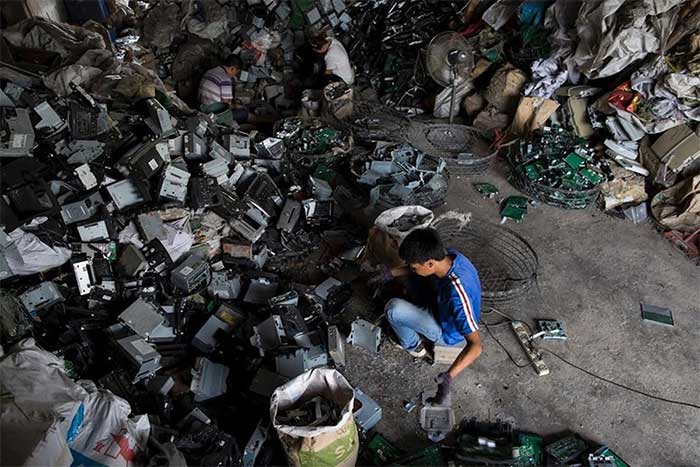Warning of an explosion of electronic waste created by AI
New research suggests that the amount of electronic waste generated by artificial intelligence (AI) could increase 2,000-fold by 2030, reaching 5 million tonnes .
The explosion of artificial intelligence (AI) over the past few years has brought many benefits to humanity. However, humans are also facing a major concern that has not yet received due attention: what will we do with the huge amount of electronic waste we have created?
'The e-waste generated by AI, especially large language models (LLMs) , could increase significantly and potentially reach 2.5 million tons per year by 2030 if no waste reduction measures are taken ,' said Asaf Tzachor, a climate and sustainability researcher at Reichmen University (Israel).

E-waste generated by AI could increase 2,000 times by 2030 - (Photo: REUTERS).
Mr. Tzachor's research team discovered that the amount of electronic waste from AI servers could reach 5 million tons by the end of this decade , about 2,000 times the amount of waste generated by AI in 2023, according to IFLScience on November 14.
The United Nations considers all types of e-waste in general a major problem, saying: "The 62 million tonnes of e-waste generated in 2022 could fill 1.55 million 40-tonne trucks, enough to line up around the equator."
Tackling the e-waste problem has many benefits. First, it prevents millions of people, including children, from dying from exposure to toxic chemicals and pollution from e-waste. At the same time, e-waste is also a valuable resource and mineral that should be recycled.
'A tonne of iPhones contains more gold and silver than a tonne of ore from a gold or silver mine ,' said Lisa McLean, a member of the research group Circular Australia.
According to research, the adoption of circular economy strategies reduces e-waste by 16% and in the best-case scenario this can be as high as 86%. The circular economy is an economic model in which design, production and service activities aim to extend the life of materials and eliminate negative impacts on the environment.
The study makes clear that the e-waste crisis is global in nature, which is why it is important to focus on cross-border e-waste management.
There is no one-size-fits-all solution, but we should aim to extend the life of existing hardware and reuse or refurbish devices and components, Tzachor said.
'It is much easier and more cost-effective to address the e-waste challenges created by AI now before they get out of control ,' Tzachor added.
The study was published in the journal Nature Computational Science.
- New technology prevents old devices from becoming toxic
- The world emits over 40 million tons of electronic waste in 2014
- The United Nations warns of the harmful effects of e-waste
- Electric waste like global time bomb
- Did you know: recycling electronic waste can benefit more than ... gold digging
- Phone is water soluble
- Extremely fast gold emulsion from electronic waste
- New technology turns waste plastic powder of electronic circuit boards into building bricks
- Japan turns 'electronic waste' into medals for the 2020 Olympics
- The 62 billion USD treasure is being forgotten in...a landfill, if not exploited, it will harm humanity.
- Electronic wrist strap that hangs lightly on the hair, is destroyed in vinegar
- Discover a new kind of explosion in the universe
 Is the magnetic North Pole shift dangerous to humanity?
Is the magnetic North Pole shift dangerous to humanity? Washington legalizes the recycling of human bodies into fertilizer
Washington legalizes the recycling of human bodies into fertilizer Lightning stone - the mysterious guest
Lightning stone - the mysterious guest Stunned by the mysterious sunset, strange appearance
Stunned by the mysterious sunset, strange appearance More than 6 million tons of plastic waste are floating in rivers, lakes and oceans.
More than 6 million tons of plastic waste are floating in rivers, lakes and oceans.  World's largest waste-to-hydrogen plant
World's largest waste-to-hydrogen plant  Concrete made from fly ash waste and glass can transmit light
Concrete made from fly ash waste and glass can transmit light  The world's largest waste-to-electricity plant
The world's largest waste-to-electricity plant  The grave of nuclear waste under the sea costs 83 billion USD
The grave of nuclear waste under the sea costs 83 billion USD  Grave of 5,500 tons of nuclear waste in Finland
Grave of 5,500 tons of nuclear waste in Finland 